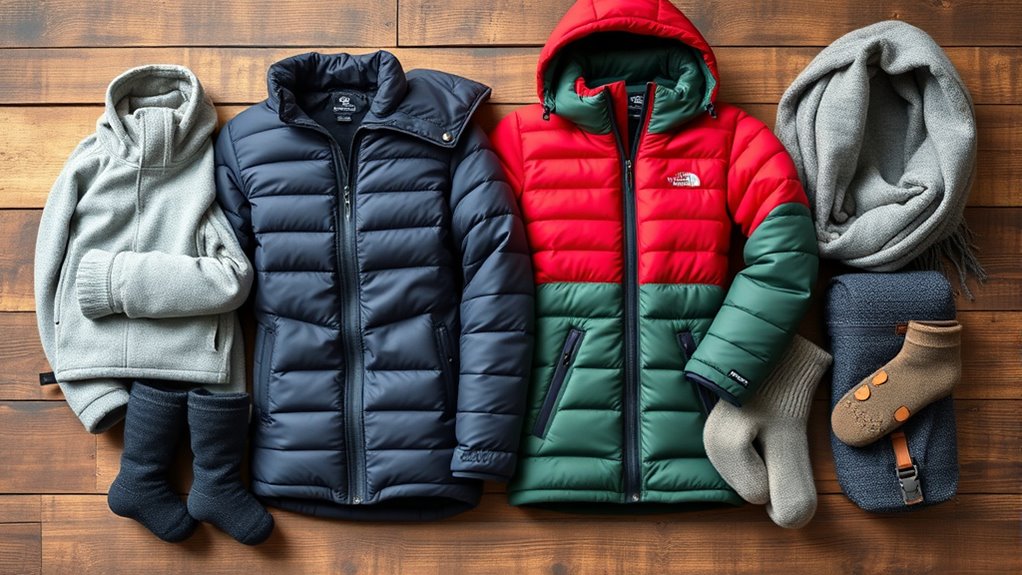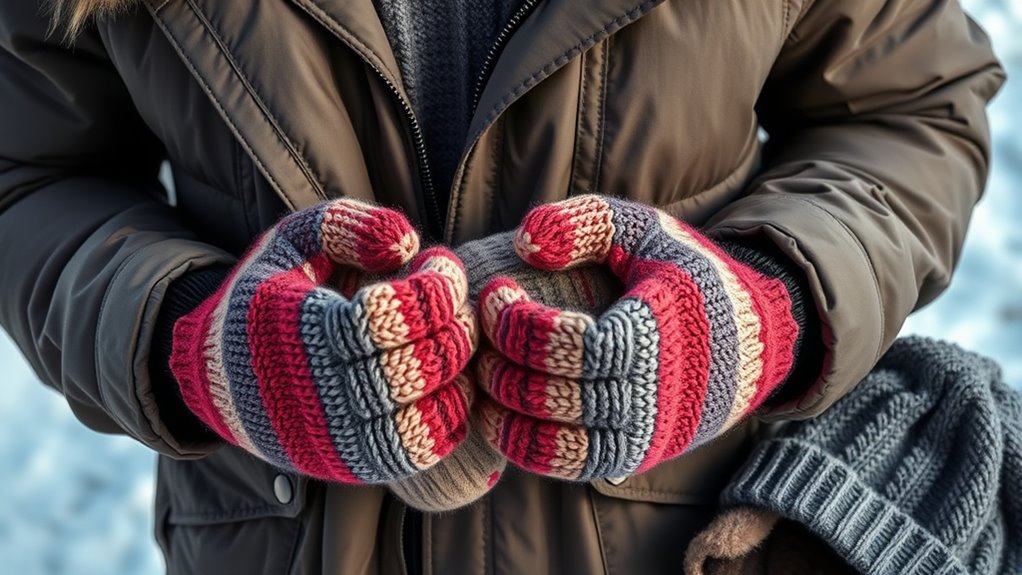To pack effectively for cold climates, focus on layering with a moisture-wicking base layer that keeps sweat away from your skin, an insulating middle layer to trap heat, and a waterproof outer shell to protect against wind and moisture. Choose materials like merino wool or synthetics designed for breathability and warmth, avoiding cotton. Proper layering guarantees comfort and safety, managing moisture and warmth efficiently. Keep exploring to discover more tips for staying warm and dry in cold environments.
Key Takeaways
- Pack moisture-wicking base layers made of merino wool or synthetic fibers to stay dry and warm.
- Include insulated layers like fleece or down to trap body heat and provide warmth.
- Choose waterproof, windproof outer shells with ventilation options to protect against weather and regulate temperature.
- Avoid cotton; opt for materials that manage moisture and allow airflow to prevent dampness.
- Use proper layering to adapt to changing conditions, ensuring each layer functions effectively for moisture and heat management.

When packing for cold climates, preparation is key to staying warm and comfortable. One of the most effective strategies you can use is the layering method, which relies heavily on understanding and utilizing thermal insulation and moisture management. This approach allows you to adjust your clothing to changing conditions and activity levels, ensuring you stay warm without overheating or becoming damp.
Start with a good base layer. This layer is essential for moisture management because it directly contacts your skin. Choose materials like merino wool or synthetic fibers designed to wick sweat away from your body. These fabrics prevent moisture buildup, which can lead to chills and hypothermia if left unchecked. Avoid cotton, as it absorbs moisture and retains it, making you feel cold and damp. A well-fitting base layer also helps trap some heat close to your body, providing initial thermal insulation.
Choose moisture-wicking base layers like merino wool or synthetic fabrics to stay dry and warm.
Over the base layer, add an insulating layer. This middle layer’s primary role is to trap body heat, creating a barrier against the cold air. Fleece, down, or synthetic insulation are popular options here. These materials have excellent thermal insulation properties, allowing you to retain warmth even in very low temperatures. The key is to choose a layer that’s warm yet breathable, so you don’t trap excess moisture inside, which can compromise your insulation and lead to discomfort.
The outer layer, or shell, protects you from wind, rain, and snow. It should be waterproof or at least water-resistant and windproof. A high-quality shell fabric prevents external moisture from penetrating your clothing while allowing moisture from your body to escape. This is vital for moisture management, as it helps keep you dry from the outside and allows sweat to evaporate from within. When selecting your outer layer, consider ventilation options like zippers or mesh-lined vents, which enable you to regulate airflow and avoid overheating during vigorous activities.
Additionally, choosing appropriate clothing materials that balance insulation and moisture-wicking properties is essential for optimal comfort and safety in cold environments.
Frequently Asked Questions
What Are the Best Materials for Thermal Insulation in Cold Weather?
You should choose insulation fabrics like wool, down, and synthetic thermal materials for cold weather. Wool is excellent because it retains heat even when damp, while down offers superior warmth-to-weight ratio. Synthetic thermal materials, such as polyester, are lightweight, quick-drying, and durable. These thermal materials work well in layered clothing, helping you stay warm and comfortable in freezing conditions. Always look for high-quality insulation fabrics tailored to your activity needs.
How Do I Prevent Moisture Buildup Between Clothing Layers?
To prevent moisture buildup between your clothing layers, you should wear moisture-wicking fabrics next to your skin, which draw sweat away and keep you dry. Choose breathable layers that allow air circulation, helping excess moisture escape. Make sure your outer layers are waterproof or water-resistant, and avoid cotton, which traps moisture. Proper layering combined with these fabrics helps you stay warm, dry, and comfortable in cold weather.
What Footwear Is Most Suitable for Icy Conditions?
Imagine you’re conquering icy terrain—insulated boots are your winter warriors, keeping your feet warm and protected. Opt for footwear with traction soles to grip slippery surfaces like a mountain goat on icy cliffs. These boots prevent slips and falls while providing insulation against the cold. Choose waterproof materials for extra protection. With the right insulated boots and traction soles, you’ll confidently navigate icy conditions, turning treacherous ice into manageable terrain.
How Should I Adjust Layering for Varying Outdoor Temperatures?
You should focus on layering flexibility to stay comfortable as outdoor temperatures change. Start with a moisture-wicking base layer, add an insulating mid-layer, and top with a waterproof outer shell. When it warms up, remove the mid-layer to prevent overheating, and add an extra layer if it gets colder. Adjusting insulation on the go helps keep you comfortable and protected, no matter the weather.
Are There Specific Accessories Essential for Extreme Cold?
Imagine you’re hiking in -20°F weather, and your fingers start freezing. You definitely need thermal gloves to keep your hands warm and insulated hats to protect your head from heat loss. These accessories are essential for extreme cold because they trap heat and prevent frostbite. Without them, your body struggles to stay warm, risking serious discomfort or injury. Always pack thermal gloves and insulated hats for extreme cold adventures.
Conclusion
As you master the art of layering, remember Gandalf’s words: “All we have to decide is what to do with the time that is given us.” By packing wisely and layering thoughtfully, you’ll be prepared to face the cold with confidence, turning a potential challenge into an adventure. Embrace the journey ahead, knowing that with the right gear, you’re ready to conquer the elements—just like heroes in their greatest quests.









